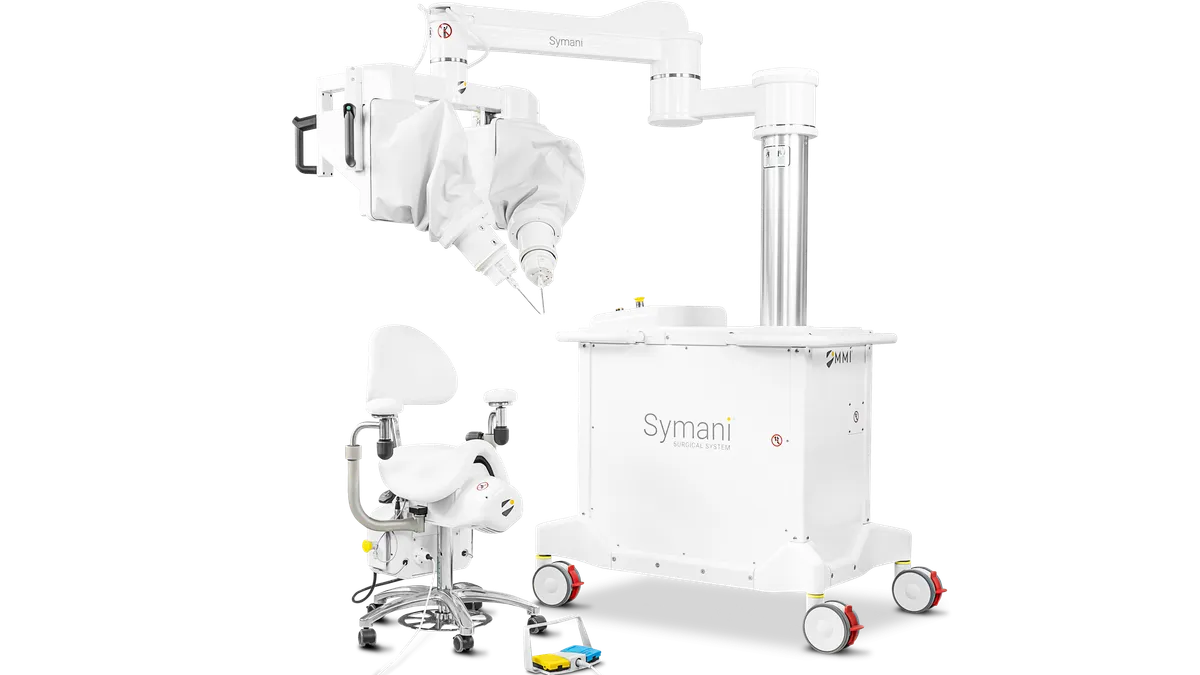Diabetes technology companies shared plans for their upcoming devices this weekend at the American Diabetes Association's Scientific Sessions.
Several firms — including Medtronic, Tandem Diabetes Care and Beta Bionics — are developing insulin patch pumps, although Insulet seems poised to be the only company on the market with a fully disposable device. Meanwhile, competitors Abbott and Dexcom are working on multi-analyte sensors, with Abbott planning to launch a device next year that can detect both glucose and ketone levels.
Here are the latest updates from the conference:
Medtronic demos next tubed pump, shares patch pump update
As Medtronic plans for a spinoff of its diabetes business, operating unit president Que Dallara gave an update on two insulin pumps in development. Medtronic provided a demonstration of its next tubed pump, the MiniMed 8-series, which is about half the size of its current 780G pump, has no screen and is controlled by a phone, RBC Capital Markets analyst Shagun Singh wrote in a research note. The company expects to submit the 8-series pump for Food and Drug Administration clearance by the close of its 2026 fiscal year, which ends next April. Medtronic plans to integrate the pump with its own Simplera glucose sensor and with competitor Abbott’s Libre sensors.
Medtronic also showcased a patch pump in development. Comparing Medtronic’s planned pump to Insulet’s Omnipod — a fully disposable device that created the market for insulin patch pumps — Medtronic’s patch pump has a semi-durable design with a rechargeable battery, J.P. Morgan analyst Robbie Marcus wrote in a research note. Medtronic’s patch pump would have a larger insulin reservoir, at 300 units, and a longer wear time, at seven days.
Dallara did not provide a timeline for the patch pump, Marcus wrote, adding he does not expect “anything material” for roughly three more years. Singh estimated the patch pump wouldn’t be in the U.S. market earlier than 2027.
Beta Bionics previews patch pump prototype
Beta Bionics unveiled a new prototype for a patch pump, called Mint. The diabetes device company, which went public in January, currently sells the iLet Bionic Pancreas, an automated insulin delivery system that uses a tubed pump.
The new device is a mix of disposable and reusable components, Marcus wrote, with a reusable piece that lasts for about two years and requires new batteries periodically. It is comparable to Insulet’s Omnipod in that both pumps last three days and take up to 200 units of insulin.
Marcus described the device as a "thoughtful form factor” and a better version of existing tubed devices, but expects Insulet to still have the advantage with the convenience of a fully disposable pump.
Tandem provides update on upcoming patch pumps
Tandem discussed plans for two upcoming patch pumps and a traditional tubed pump. The company is working on its t:slim X3 pump, a successor to its line of tubed pumps, which features better processing capabilities, battery life and durability, Singh wrote.
The company is also working on a tubeless option for its smaller Mobi insulin pumps and a separate patch pump called Sigi, which will be rechargeable and come with pre-filled insulin cartridges. Tandem did not share timelines for any of the three pumps, but is expected to debut the t:slim X3 first, followed by Mobi tubeless and then Sigi, Singh wrote.
Abbott to launch a glucose-ketone sensor next year
Abbott has struck several partnerships around a planned dual-analyte sensor that can detect glucose and ketones. The device, Abbott claims, can help people with diabetes avoid a serious condition called diabetic ketoacidosis by detecting a rise in ketones early. A panel at ADA debated the clinical need for continuous ketone monitoring.
Leading up to the conference, Tandem, Sequel Med Tech and Beta Bionics said they would integrate their insulin pumps with Abbott’s planned sensor.
Abbott is preparing for a commercial launch sometime next year, and expects the sensor to be integrated with all major automated insulin delivery systems, BTIG analyst Marie Thibault wrote in a research note. The company hopes to gain market share in the U.S. with the new sensor.
Dexcom’s next sensor will also have multi-analyte capability
Dexcom’s next continuous glucose monitor, the G8, is currently in human feasibility trials, J.P. Morgan’s Marcus wrote. The sensor will last for 15 days, have a smaller form factor than Dexcom’s current G7, and support multi-analyte capabilities. Dexcom has not yet said which analytes it will support, such as the ability to monitor ketone levels. Marcus expects the device could reach the market as soon as 2027 or 2028.
Senseonics discusses future iterations of implantable CGM
Senseonics, which makes an implantable glucose sensor that can be worn for one year, discussed future iterations of the device at the conference. The company is working on a version called Gemini, which is fully implantable and self-powered. The company plans to start a study later this year, followed by a commercial launch in the fourth quarter of 2026, BTIG’s Thibault wrote. Further out, the company is working on a version that requires no transmitter, called Freedom. That sensor is in prototype testing, according to Thibault.
Less discussed: over-the-counter sensors
The ADA conference featured a debate on the benefits and risks of over-the-counter CGMs, but developers of the devices had few updates to share at the conference.
Abbott and Dexcom launched the first over-the-counter CGMs last year. Dexcom’s Stelo was geared toward people with Type 2 diabetes who don’t take insulin, although it could also be used by people who have prediabetes or don’t have diabetes. Abbott’s Lingo was more wellness-oriented, intended for people who don’t have diabetes.
Abbott said last year it was also working on a separate, over-the-counter device, called Rio, intended for people with Type 2 diabetes who don’t take insulin. When asked by MedTech Dive, an Abbott spokesperson said the company does not have a timeline for launch, adding that “right now, our efforts are focused on getting more people access and coverage for our current portfolio of Libre CGMs.”





















